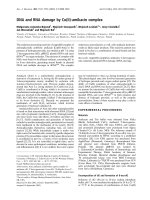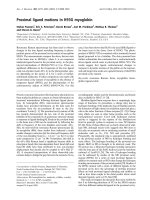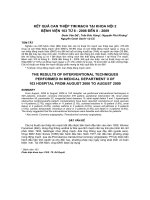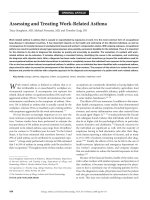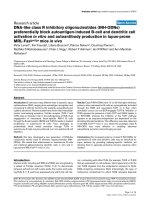Báo cáo y học: "DNA replication can still spring surprises" ppt
Bạn đang xem bản rút gọn của tài liệu. Xem và tải ngay bản đầy đủ của tài liệu tại đây (46.61 KB, 2 trang )
Genome
BBiioollooggyy
2008,
99::
317
Meeting report
DDNNAA rreepplliiccaattiioonn ccaann ssttiillll sspprriinngg ssuurrpprriisseess
Heather L Hendrickson
Address: Microbiology Unit, Department of Biochemistry, University of Oxford, South Parks Rd, Oxford, OX1 3QU, UK.
Email:
Published: 07 August 2008
Genome
BBiioollooggyy
2008,
99::
317 (doi:10.1186/gb-2008-9-8-317)
The electronic version of this article is the complete one and can be
found online at />© 2008 BioMed Central Ltd
A report of the first EMBO conference in a biennial series
‘Replication and Segregation of Chromosomes’, Geilo,
Norway, 16-20 June 2008.
The first EMBO conference on the replication and segrega-
tion of chromosomes held recently in Norway brought together
researchers from around the world. Many different tech-
niques and organisms are being used to approach one of the
oldest problems in biology: how does one organism become
two? The breadth of work covered was exceptional; this
report describes just a few of the most striking innovations
in technology and concepts presented at the meeting, with
particular reference to bacterial DNA replication.
Antoine van Oijen (Harvard Medical School, Boston, USA)
amusingly described the problem of ensemble averaging in
DNA replication as an alien race concluding that humans
must each have one testicle and one ovary. To avoid this
pitfall, his group makes single-molecule observations of the
four-protein replisome of the phage T7. The copy of gp5 (the
DNA polymerase) acting on the lagging strand can be
washed away, allowing observation of the processivity of
leading-strand replication in isolation. Measurements of
processivity are possible because the passage of the replica-
tion fork on the tethered DNA causes long double-stranded
(ds) DNA to be transformed into more compact single-
stranded (ss) DNA. Restoring the second polymerase and
adding the T7 single-strand binding protein makes the
looping out of lagging strand DNA itself observable as
transient changes in the length of the tethered DNA.
The archaea are apparent amalgams of eukaryotic and
eubacterial traits. Their replication machinery is homolo-
gous to that of eukaryotes despite their eubacteria-like
circular chromosomes; most distinctively, archaea can have
multiple origins of replication in these circular chromo-
somes. Stephen Bell (University of Oxford, UK) described
his laboratory’s investigations into DNA replication in the
archaeal genus Sulfolobus. He and his colleagues are
characterizing the proteins EscrtIII, which is unique to
archaea, and Vps4, which is also found in eukaryotes. These
proteins are of interest as alteration in their expression results
in defects in DNA segregation. Uncovering the mechanisms of
DNA maintenance in the third domain of life might also shed
light on more complicated eukaryotic systems.
Ever since Watson and Crick first proposed their model of
DNA replication, the topological problem of overwinding
the helix during its duplication has been obvious. One
solution is the type I and type II DNA topoisomerases,
which act to reduce the winding by passing a strand of DNA
through one or two strands, respectively. Where do these
topoisomerases act in relation to the replication fork?
Marcelo Foiani (Fondazione Italiana per la Ricerca sul
Cancro, Milan, Italy) described his group’s chromatin
immunoprecipitation-DNA microarray analysis of
synchronized yeast cultures in early S phase. They have
found that the topoisomerases Top1 and Top2, type I and
type II topoisomerases, respectively, localize close to the
replication forks themselves. This would suggest that
topological transitions are being performed constantly
during replication and within 600 bp (the resolution limit of
these experiments) of the replication forks. Foiani has also
begun similar work identifying the locations of replication
termination in yeast and is searching for possible
termination-associated factors. Intriguingly, he reported
that replication forks approaching each other appear to
pause before they are resolved in this system.
The understanding of the replication of bacterial chromo-
somes has recently experienced an upheaval. David Sherratt
(University of Oxford, UK) presented the latest news on the
death of the stationary ‘replication factory’ model of DNA
replication in Escherichia coli, reporting the work of his
colleague Rodrigo Reyes, who has fluorescently labeled
many of the components of the DNA replication machinery
to track the progress of the replication forks in vivo. The
primary conclusions of these experiments is that at short
time scales the replisome assembled at each replication fork
moves separately along what is assumed to be the path of the
compacted DNA. Replisomes move away from each other in
the general direction of opposite cell poles until near the
completion of replication, when they come back together.
These observations defy the possibility of a stationary
replication factory from which the nascent DNA is extruded,
at least in E. coli.
Is the factory model’s epitaph premature or have we yet to
appreciate the extent of variation among bacterial species?
Perhaps the most controversial talk at the meeting was the
description by Sigal Ben-Yehuda (Hebrew University of
Jerusalem, Israel) of a novel method for illuminating the
large-scale spatial details of DNA replication in Bacillus
subtilis in real time. Her group has recently developed a
method for following the incorporation of fluorescently
labeled nucleotides into the DNA of growing cells. The
images that result from this new technique imply that the
DNA is kept in large helical loops within the cytoplasm and
that these appear to spin out from presumed replication
factories that remain at mid-cell. Eventually DNA loops back
from the poles to fill a central channel as replication
proceeds. If validated, this technique will be a major step
forward in monitoring the progress of DNA replication in
live cells; most importantly, such labeling techniques could
be used in ‘normal’ non-mutant cells of any species. Caution
is warranted at this stage, however, in that the nucleotide
incorporation must be confirmed to be taking place at
replication forks and not represent damage-induced replica-
tion or repair events.
Once the bacterial chromosome has been replicated, the two
copies must be separated and accurately segregated to the
daughter cells. Jeffrey Errington (University of Newcastle,
UK) presented his colleague Heath Murray’s most recent work
on bacterial chromosome segregation in B. subtilis. Errington
described the Soj gene (a ParA homolog), which is located in
the chromosome next to SpoOJ, a ParB homolog necessary for
accurate chromosome segregation in this system. Soj encodes
an activator/inhibitor protein that controls replication initia-
tion through interactions with DnaA, the origin initiation
protein. Interactions between these neighboring proteins
coordinate replication with segregation. The phenotypic
characterization depended on some nice fluorescent work and
mutant Soj proteins that either lack ATPase activity or cannot
dimerize. One of the more interesting exchanges in the
meeting came when Errington was asked, “Why does E. coli
not use the ParAB system?” Many view E. coli as the prime
model system for everything bacterial, but unlike many other
bacteria, it does not use the ParAB system for chromosome
segregation. Errington’s response was clear: “I think E. coli is
a real weirdo.”
Whether E. coli is representative or not, Frédéric Boccard
(CNRS Centre de Génétique Moléculaire, Gif-sur-Yvette,
France) and his colleagues have beautifully established the
presence of what appears to be a chromosome domain
organizer for the terminus region in E. coli: the protein
MatP, which binds to a 13-bp sequence (matS) found 23
times and only in the terminus region. In the absence of
MatP there was a decrease in chromosome condensation in
the terminus region as well as a lack of cohesion of the
terminus after replication. Boccard’s approach combines
bioinformatics and genetic techniques and is revealing
domains of organization in E. coli that satisfyingly parallel
those found in B. subtilis and other bacteria. Altogether, the
work discussed above shows that although the tasks being
accomplished are similar, the mechanisms that have evolved
in different bacterial species to organize and segregate
genomes can vary as much as the multitude of lifestyles
these organisms have adapted to.
Some would argue that there is no greater goal in life than to
replicate and segregate DNA. As new techniques are brought
to bear on the understanding of this most basic problem, the
myriad of mechanisms revealed continue to surprise and
challenge conventional wisdom.
/>Genome
BBiioollooggyy
2008, Volume 9, Issue 8, Article 317 Hendrickson 317.2
Genome
BBiioollooggyy
2008,
99::
317
